The Structure of DNA
(The Double Helix)
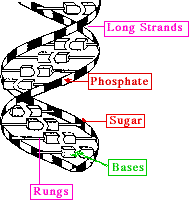
DNA is made up of six smaller molecules -- a five carbon sugar called deoxyribose,
a phosphate molecule and four different nitrogenous bases (adenine, thymine,
cytosine and guanine). Using research from many sources, including chemically
accurate models, Watson and Crick discovered how these six subunits were
arranged to make the the structure of DNA. The model is called a double
helix because two long strands twist around each other like a twisted ladder.
The rails of the ladder are made of alternating sugar and phosphate molecules.
The steps of the ladder are made of two bases joined together with either
two or three weak hydrogen bonds.

Nucleotides
The basic building block of DNA is called a NUCLEOTIDE. A nucleotide is
made up of one sugar molecule, one phosphate molecule and one of the four
bases. Here is the structural formula for the four nucleotides of DNA. Note
that the purine bases (adenine and guanine) have a double ring structure
while the pyrimidine bases (thymine and cytosine) have only a single ring.
This was important to Watson and Crick because it helped them figure out
how the double helix was formed.
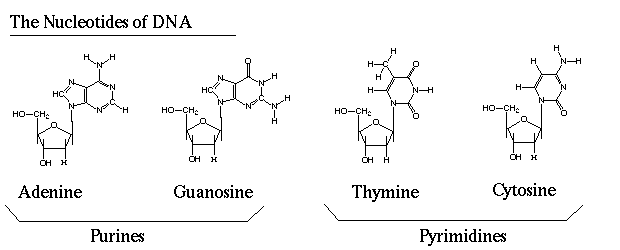
These pictures show a ball and stick model of two DNA nucleotides. Gray
balls are carbon atoms, blue balls are nitrogen, red balls are oxygen and
the pink ball is phosphorous. The hydrogen atoms are not shown.
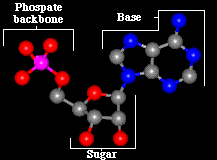
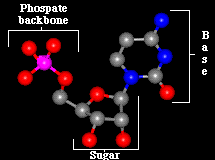
Adenine Nucleotide (purine) Cytosine Nucleotide (pyrimidine)

Base Pairs
The nucleotides of DNA line up so that the sugar and phosphate molecules
make two long backbones like the handrails of a ladder. To make the rungs
of the ladder, two bases join together, between the sugar molecules on the
two handrails. The phosphate molecules do not have any "rungs"
between them. THERE IS ONLY ONE WAY THE BASES CAN PAIR UP ON THE RUNGS OF
THE DNA LADDER. An adenine molecule only pairs with a thymine. A cytosine
only pairs with a guanine. They can pair in either order on a rung, giving
four possible combinations of bases --
A-T or T-A and C-G or G-C
Believe it or not, it is this chain of base pairs that makes up the code
that controls what everything looks like. (See How DNA Works to learn how.)
Below is a picture showing how the bases pair. You will see that a purine
with two rings always pairs with a pyrimidine with one ring. In this way
the width of the DNA molecule stays the same. The dotted lines represent
weak hydrogen bonds. These form between parts of the molecules that have
weak positive and negative charges. Because the hydrogen bonds are weak,
they are able to break apart more easily than the rest of the DNA molecule.
This is important when DNA reproduces itself and when it does its main work
of controlling traits that determine what an organism looks like.
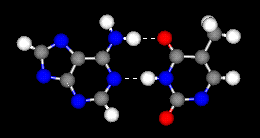
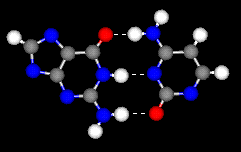
Adenine and Thymine pairing ***** Guanine and Cytosine pairing

The Double Helix Model
In this model of a very short section of DNA you can see how the A-T
and C-G base pairs make up the rungs of the ladder and the sugars and phosphates
make up the two long strands. In this picture the DNA is not twisted. The
DNA in one chromosome would actually be hundreds of thousands of bases long
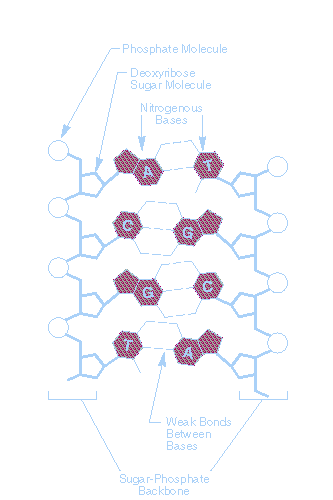

These two models shows how all the atoms of the sugars, phosphates and
nitrogenous bases fit together to make the "spiral staircase"
or "twisted ladder" shape first suggested by the x-ray diffraction
pictures of DNA taken by Rosalind Franklin and Maurice Wilkins.
 ********
********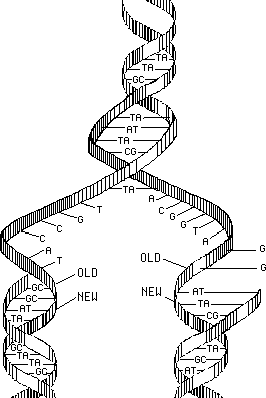
Back to the Index
Or try these Internet siites to see how colleges teach about the structure
of DNA






 ********
********